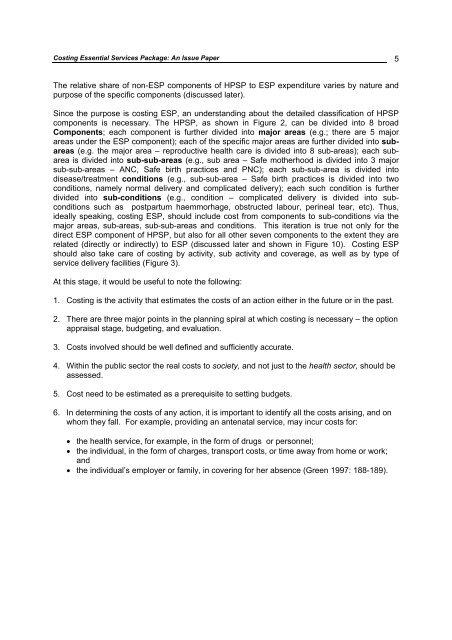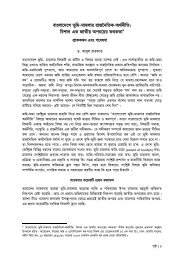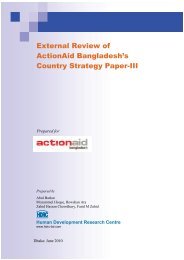08. Costing Essential Services Package An Issue Paper
08. Costing Essential Services Package An Issue Paper
08. Costing Essential Services Package An Issue Paper
Create successful ePaper yourself
Turn your PDF publications into a flip-book with our unique Google optimized e-Paper software.
<strong>Costing</strong> <strong>Essential</strong> <strong>Services</strong> <strong>Package</strong>: <strong>An</strong> <strong>Issue</strong> <strong>Paper</strong> 5<br />
The relative share of non-ESP components of HPSP to ESP expenditure varies by nature and<br />
purpose of the specific components (discussed later).<br />
Since the purpose is costing ESP, an understanding about the detailed classification of HPSP<br />
components is necessary. The HPSP, as shown in Figure 2, can be divided into 8 broad<br />
Components; each component is further divided into major areas (e.g.; there are 5 major<br />
areas under the ESP component); each of the specific major areas are further divided into subareas<br />
(e.g. the major area – reproductive health care is divided into 8 sub-areas); each subarea<br />
is divided into sub-sub-areas (e.g., sub area – Safe motherhood is divided into 3 major<br />
sub-sub-areas – ANC, Safe birth practices and PNC); each sub-sub-area is divided into<br />
disease/treatment conditions (e.g., sub-sub-area – Safe birth practices is divided into two<br />
conditions, namely normal delivery and complicated delivery); each such condition is further<br />
divided into sub-conditions (e.g., condition – complicated delivery is divided into subconditions<br />
such as postpartum haemmorhage, obstructed labour, perineal tear, etc). Thus,<br />
ideally speaking, costing ESP, should include cost from components to sub-conditions via the<br />
major areas, sub-areas, sub-sub-areas and conditions. This iteration is true not only for the<br />
direct ESP component of HPSP, but also for all other seven components to the extent they are<br />
related (directly or indirectly) to ESP (discussed later and shown in Figure 10). <strong>Costing</strong> ESP<br />
should also take care of costing by activity, sub activity and coverage, as well as by type of<br />
service delivery facilities (Figure 3).<br />
At this stage, it would be useful to note the following:<br />
1. <strong>Costing</strong> is the activity that estimates the costs of an action either in the future or in the past.<br />
2. There are three major points in the planning spiral at which costing is necessary – the option<br />
appraisal stage, budgeting, and evaluation.<br />
3. Costs involved should be well defined and sufficiently accurate.<br />
4. Within the public sector the real costs to society, and not just to the health sector, should be<br />
assessed.<br />
5. Cost need to be estimated as a prerequisite to setting budgets.<br />
6. In determining the costs of any action, it is important to identify all the costs arising, and on<br />
whom they fall. For example, providing an antenatal service, may incur costs for:<br />
� the health service, for example, in the form of drugs or personnel;<br />
� the individual, in the form of charges, transport costs, or time away from home or work;<br />
and<br />
� the individual’s employer or family, in covering for her absence (Green 1997: 188-189).






